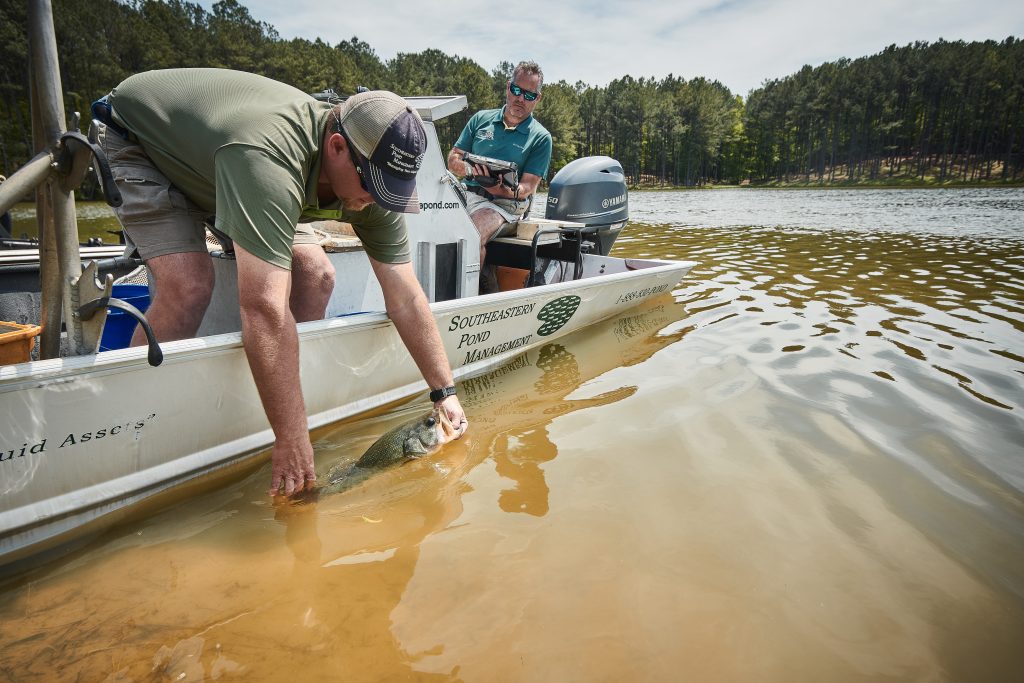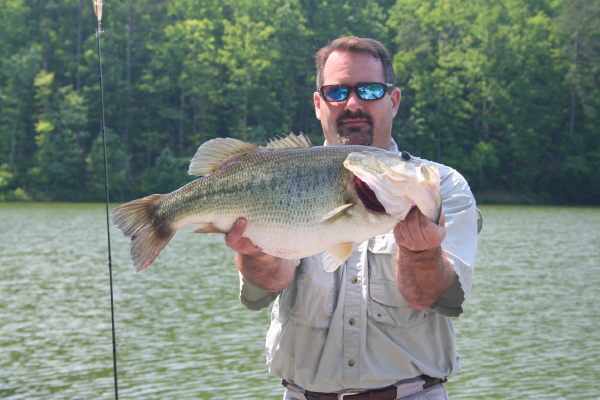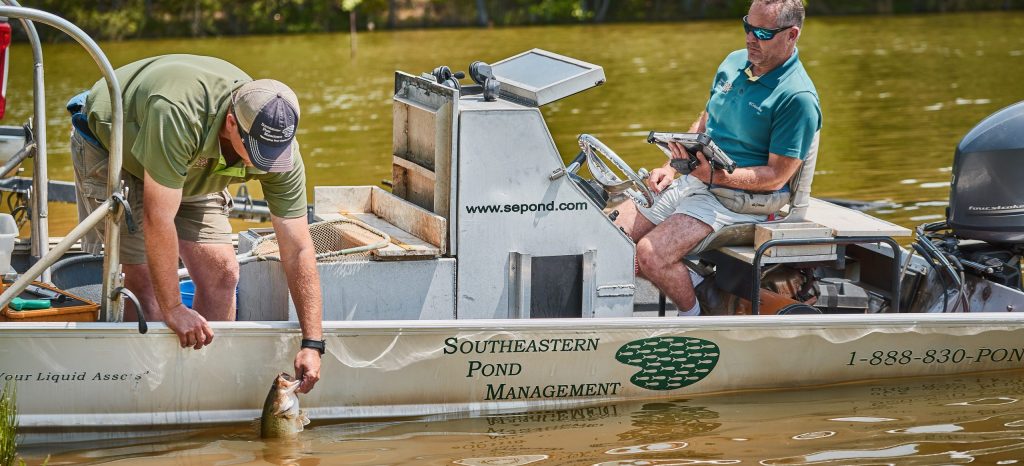Let’s face it, most meat eaters love big juicy (rare for me) steaks. Who doesn’t love to see their favorite sports team win a game against their biggest rival or even better, a championship. Most rifle hunters want the biggest bullet moving as fast as possible and every true bass fisherman loves to catch trophy sized fish from their bass pond.
If you own a bass pond, chances are that you want to grow the biggest bass you can with the resources you have, but the question is how do you do that? It isn’t a matter of just throwing some bass in and along with a bunch of forage fish in a pond and expecting to have a trophy bass paradise overnight. It takes planning, work, and time.
To get the real skinny on what to do we reached out to Norman Latona, founder, and CEO of Southeastern Pond Management.
SEPond, headquartered in Birmingham, Alabama with satellite offices in Auburn, Al, Canton, MS, and Jackson, TN offers a complete range of pond services ranging from pond construction and improvement, stocking, liming, fertilizing, and getting ponds up to speed from a professional management and implication perspective.
Latona points out that for a large number of SEPond customers (if not the majority) the ultimate objective is to grow really big bass and he and his team spend a lot of time implementing management steps geared toward making that happen.

First things first. Latona defines a “trophy bass” to be a fish greater than 20 inches in total length and those fish can weigh from seven to eight pounds and up. The SEPond management philosophy is that three major components have to be present to allow a pond to be a trophy bass factory. Those components are age, nutrition, and genetics and they all need to work hand in hand if a pond owner is going to produce trophy bass.
How To Grow Big Bass In A Pond
Fact…it is impossible to produce trophy bass without the age component. Bass, regardless of the forage and genetic aspects, don’t go from fry to three-pound bass in a year. Depending on the pond environment, nutrition variables, and genetics, it may take three years and more for a bass to grow to the trophy range. That is with an ideal environment.
“At the end of the day it takes some age, which means time, to produce trophy bass and you can’t do it overnight,” Latona said. “Once those fish get to that 16–17-inch range they have the potential to become real trophies and you want to protect them with practices such as catch and release and maybe even supplemental feeding.”
Nutrition Requirements For Trophy Bass Pond
“Nutrition is the one component that has the greatest direct impact on trophy fish production and is the easiest one of the three for us to utilize,” Latona said. “We can analyze what kind of food is available, how abundant it is, what are the sizes and diversity of the forage base then take steps to enhance that forage base which has a direct impact on the growth rate of the individual fish,”
“The more we increase and enhance the food availability, we increase the growth rate of the bass and decrease the time required to attain trophy status. That is where we spend most of our time and effort since that is where we can have the greatest effect,” he pointed out.
Building a self-sustainable forage base doesn’t just mean adding more forage fish into the mix. The quality of the water, and the amount of nutrients to feed those forage fish in order for them to grow to become a good mouthful for a voracious big bass is a matter of keeping everything in sync. That isn’t an easy task considering all of the variables.
A More Fertile Bass Pond Environment
“If we can create better water quality, a more fertile environment, with adequate phytoplankton development, we can stimulate more forage production, which translates ultimately into more food for the bass and they’re swimming around that we’re trying to grow,” Latona explained. “So, all these inputs, whether it’s liming, fertilizing, supplemental feeding, supplemental stocking, and other management tools, all these inputs contribute to producing a greater amount of forage, which ultimately enhances the bass’s ability to grow and become true trophies.”
Big Bass Genetics
If the fish have the opportunity to age and have optimal nutrition then the last component that comes into play is genetics. Does that fish genetically have the ability to grow into trophy size?
Latona pointed out that there presently is a lot of research being conducted on fish genetics with an emphasis on selective breeding in order to produce fish that exhibit high and rapid growth rates, the ability to reach maximum sizes, and display aggressive behavior and other traits.
“The magic in growing trophy bass is the ability to combine all three of these components working in concert to constantly produce trophy bass,” Latona said.
Once a pond has been developed and” tweaked” to be in the trophy bass-producing category, it becomes a matter of keeping all of the components in balance. This is more of a challenge than it may seem on the surface.

The reality is that each pond is different and conditions change from year to year and can rapidly change if the composition of the pond and resultant output.
For example, one year you may see a natural increase in the number of bass fry which results in heavier pressure on the forage base, and if that isn’t handled by increased bass harvesting a pond can become “bass predator” crowded very quickly which will result in a decrease in the size of the bass. That defeats the whole purpose of taking steps to increase trophy bass output.
“If you don’t stay on top of that condition, it will quickly end up with a bass crowded condition and it impacts the whole lake, the forage available for the bass, the competition among them and it can set back your efforts to grow that wall mountable trophy bass,” Latona said.
Trophy Pond Management Experts
“It is highly valuable to have a management company and a fish biologist to come out on an annual basis and look at the fish community, both predator and forage and make a ‘snapshot in time” and give an assessment as to where we are today, relative to where we were 12 months ago and here is where we need to make adjustments, Latona said. That way there is no guesswork. We can do some electroshocking and weigh, measure, and count them and give educated advice as to what needs to be done, if anything, to get the pond to an even keel.”
The bottom line on all of this is relatively simple in concept but complicated to implement. There has to be enough food for the bass to eat to grow to trophy size. That means forage fish. The forage fish need to be plentiful but of the right size to fit into a bass’s mouth. The bass population has to be kept “in check” so they don’t, borrowing a term from the deer hunting community, “over browse the range”.
If the bass multiply too much, the population has to be reduced. Trying to do this with hook and line is almost impossible and the only viable alternative is electroshocking, which is beneficial in that it allows you to decide what fish to harvest and which to return to the water and provides information at the same time.
Trophy pond management is all about balance and continuous vigilance and commitment.




